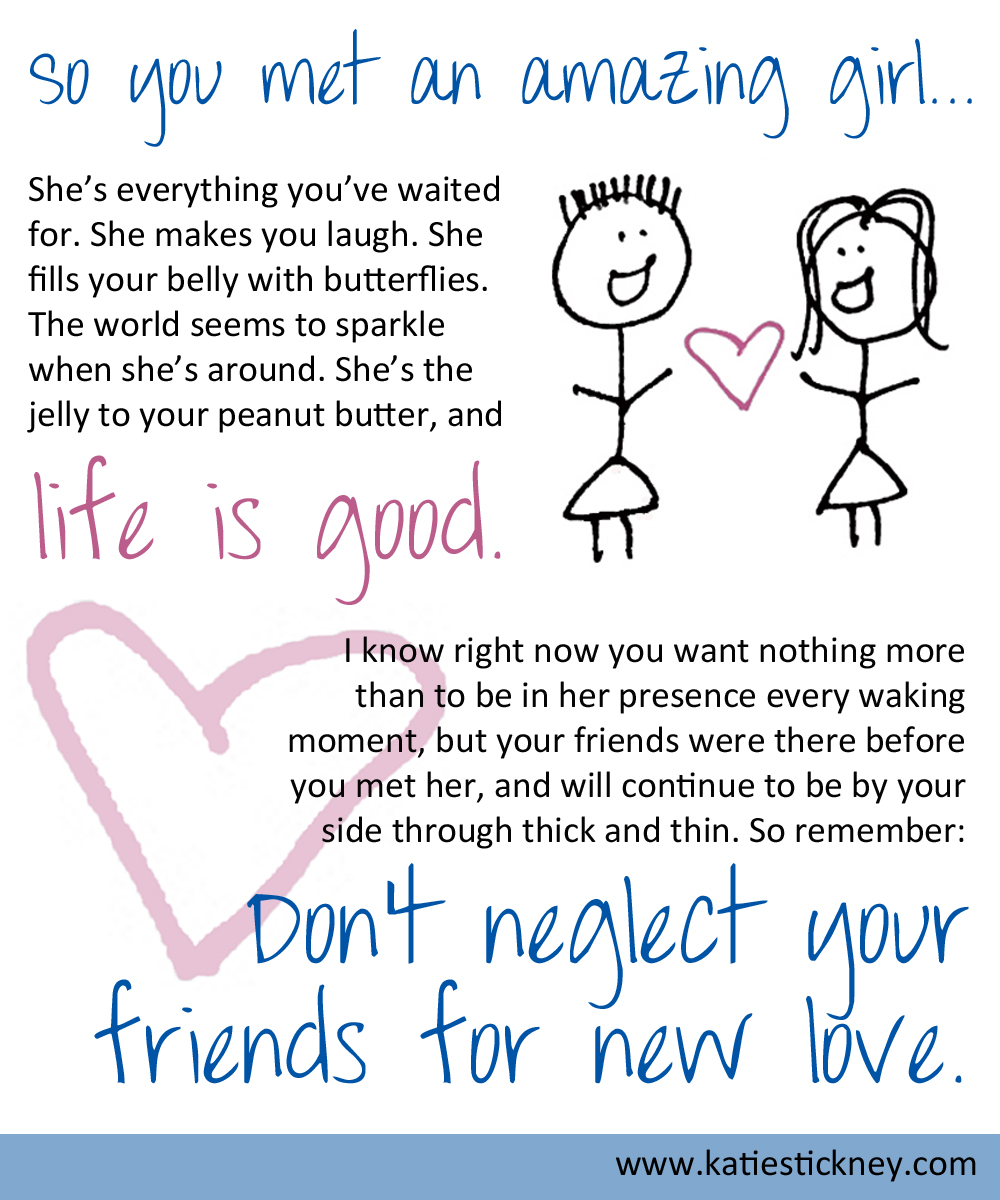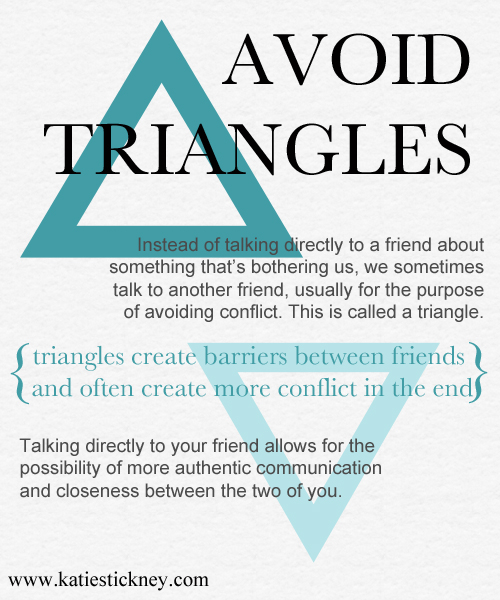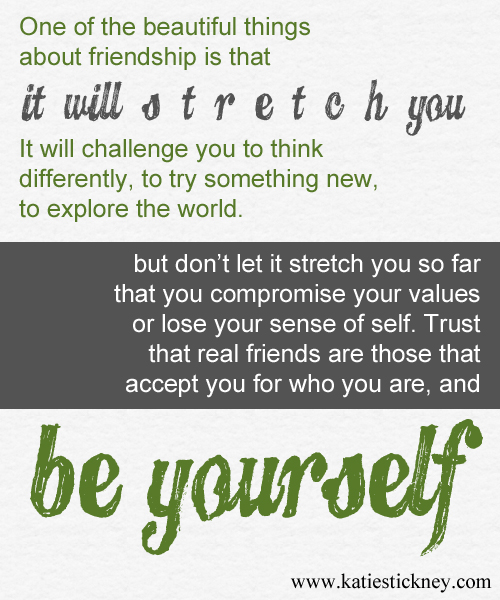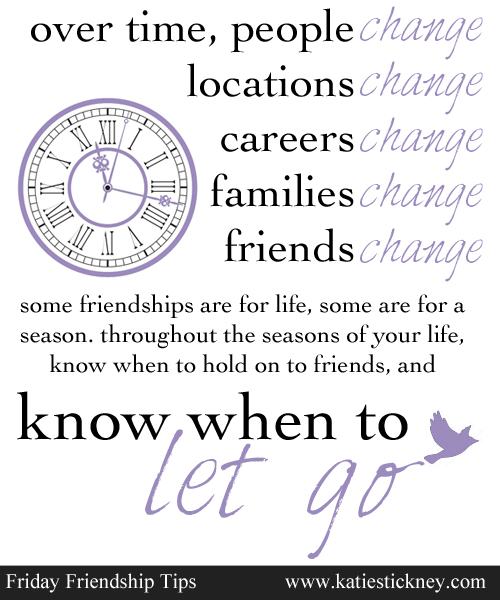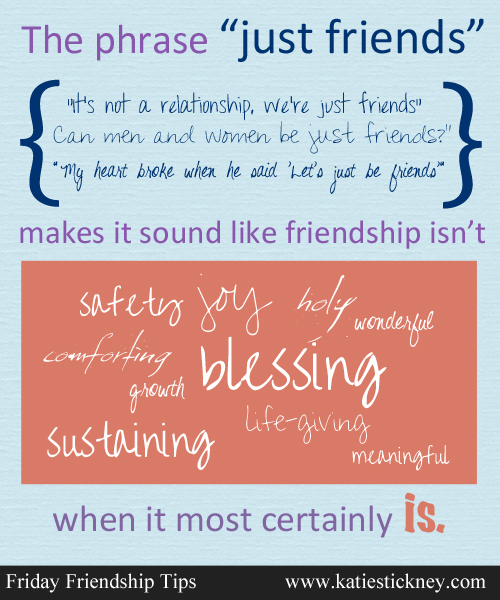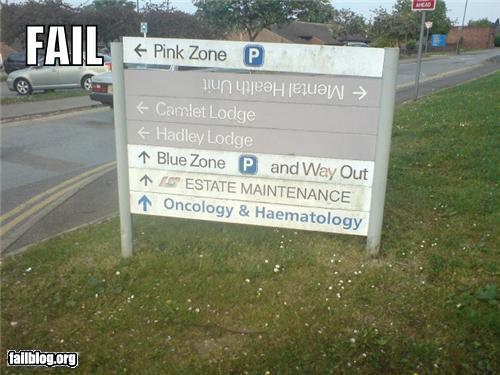About Friday Friendship Tips: Friendship is often overlooked in our society, dropped down the priority list below our partners, children, other family members, and even our career. We often underestimate the power of friendship as a source of encouragement, strength, and joy in our lives, yet we often feel its lack in our lives. I am frequently asked, “How can I find more friends? How can I make the friendships I do have more fulfilling?” Through this series, I will be offering small meditations that I hope will help you turn your attention toward friendship and help you to prioritize it.
About Friday Friendship Tips: Friendship is often overlooked in our society, dropped down the priority list below our partners, children, other family members, and even our career. We often underestimate the power of friendship as a source of encouragement, strength, and joy in our lives, yet we often feel its lack in our lives. I am frequently asked, “How can I find more friends? How can I make the friendships I do have more fulfilling?” Through this series, I will be offering small meditations that I hope will help you turn your attention toward friendship and help you to prioritize it.
About Friday Friendship Tips: Friendship is often overlooked in our society, dropped down the priority list below our partners, children, other family members, and even our career. We often underestimate the power of friendship as a source of encouragement, strength, and joy in our lives, yet we often feel its lack in our lives. I am frequently asked, “How can I find more friends? How can I make the friendships I do have more fulfilling?” Through this series, I will be offering small meditations that I hope will help you turn your attention toward friendship and help you to prioritize it.
About Friday Friendship Tips: Friendship is often overlooked in our society, dropped down the priority list below our partners, children, other family members, and even our career. We often underestimate the power of friendship as a source of encouragement, strength, and joy in our lives, yet we often feel its lack in our lives. I am frequently asked, “How can I find more friends? How can I make the friendships I do have more fulfilling?” Through this series, I will be offering small meditations that I hope will help you turn your attention toward friendship and help you to prioritize it.
About Friday Friendship Tips: Friendship is often overlooked in our society, dropped down the priority list below our partners, children, other family members, and even our career. We often underestimate the power of friendship as a source of encouragement, strength, and joy in our lives, yet we often feel its lack in our lives. I am frequently asked, “How can I find more friends? How can I make the friendships I do have more fulfilling?” Through this series, I will be offering small meditations that I hope will help you turn your attention toward friendship and help you to prioritize it.
I spend Wednesdays in the Green Lake neighborhood. While driving home via I-5 south, it’s not uncommon to see folks standing on the bridges over the freeway, holding political signs and waving at the stop-and-go traffic below.
This evening, a man was standing on the 45th street bridge holding an “Approve 74” sign with a simple “Thank You” sign above it. I waved at him, as my car crawled slowly toward the bridge. He waved back at me, and pointed enthusiastically at the thank you part of the sign, and I burst into tears.
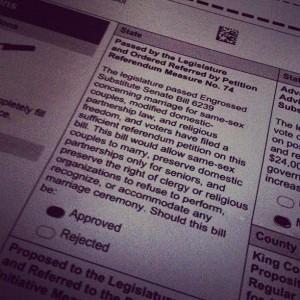 In my tears were several mixed emotions. I was moved by his joy and gratitude. I was feeling relief from the months of anxiety I’ve carried about this referendum. I felt angry that he hadn’t had this right all along, and that his rights had been put in the hands of the voters at all. I felt sad and disappointed that the margin is still so close that the officials are not yet willing to call it a win.
In my tears were several mixed emotions. I was moved by his joy and gratitude. I was feeling relief from the months of anxiety I’ve carried about this referendum. I felt angry that he hadn’t had this right all along, and that his rights had been put in the hands of the voters at all. I felt sad and disappointed that the margin is still so close that the officials are not yet willing to call it a win.
Despite all that, here this man was, willing to stand in the cold, breathing in all the exhaust fumes from the cars below, to demonstrate his gratitude for the WA voters who had approved 74.
I actually have mixed feelings about marriage in general. While I have experienced the benefits of a good marriage, I am also aware of the ways marriage can become problematic or harmful. I am all too aware of its patriarchal roots, the way that throughout most of human history marriage has been a way to codify male ownership of women. I am uncomfortable with the way our cultural focus on marriage upholds the pair-bond as the ultimate human relationship. I would whole-heartedly support models that would get the state out of the marriage business altogether, opening up new legal avenues to give rights (hospital visitation, etc.) to anyone we choose. Many of my gay and lesbian friends express their concern that marriage is the fight of the privileged, and that less privileged gay men and lesbian women have other, much more urgent, needs. All of these things remain caveats in my mind when I am thinking about marriage equality.
And yet.
Like the man waving enthusiastically out in the cold despite the obvious problems with it having been on the ballot at all, I remain hopeful and joyful about the passing of Referendum 74 despite my concerns about marriage. This is one more step toward justice. This is a sign that previously closed minds and hearts can be opened by truth and love. Even with all those concerns and caveats mentioned above, this is still a beacon of hope.
One of several theoretical orientations in which my counseling practice is rooted is that of Health At Every Size. The phrase was coined by Linda Bacon [correction: used by Linda Bacon, but not coined by her, as explained in her comment below] in her book Health At Every Size: The Surprising Truth About Your Weight. The phrase took off and is now used by many folks in a variety of helping professions, particularly health care workers, who have pledged their support for HAES as defined here:
Health at Every Size is based on the simple premise that the best way to improve health is to honor your body. It supports people in adopting health habits for the sake of health and well-being (rather than weight control). Health at Every Size encourages:
- Accepting and respecting the natural diversity of body sizes and shapes.
- Eating in a flexible manner that values pleasure and honors internal cues of hunger, satiety, and appetite.
- Finding the joy in moving one’s body and becoming more physically vital.
From a purely logical standpoint, these principles are wholly uncontroversial.
And yet, somehow it still seems that controversy around these principles, and the theoretical orientation of HAES as a whole, abounds. Those of us who support HAES, and call into question theories, diet plans, studies, etc. that privilege body size/weight over health, offering instead these very reasonable and boringly obvious principles, are routinely responded to with an emotional strength—and sometimes viciousness—that we find surprising. But if we search deep down in ourselves, even some of us HAES supporters and practitioners sometimes have trouble really integrating the principles. We accept them logically, and yet it is hard to really feel like we believe them deep down.
I have given a lot of though to why this might be, and I believe it’s because HAES shines a light into the dark corners where we cling to power and control, and ultimately illuminates our unconscious terror of death.
Now I would bet that I might have just lost you. I would bet that while some of you reading this might agree that you are afraid of death, many of you would say that you do not worry about or fear death, or even really think about it. And I believe that’s true, albeit on a conscious level. But I am not talking about conscious thoughts or worries, I am talking about unconscious anxiety and terror.
One of the things that sets humans apart from other animals is that we have a deep capacity for self-awareness. Self-awareness—being aware of the existence of the self in space and time—brings with it an awareness that we will some day cease to be. That one day we will die. Therapists and philosophers might use the term “existential terror” to discuss the unconscious anxiety this provokes.
And I think this is why conversations about health and body size/weight are so emotionally charged for many of us. We are not conscious about our anxiety that ultimately we are not in control of these bodies in and through which we experience the world. We are not consciously aware of the existential terror that we feel about the prospect that our bodies will get old, broken, ill, and eventually, we will die.
This is all unconscious because facing the reality of the inevitability of illness and death is scary and painful. It is much easier to avoid, ignore, repress that awareness and the feelings that come with it. And one of the best ways to do that is to convince our conscious selves that we are in control. That if we eat the “right” foods, in the “right” amounts, and we move in the “right” ways for the “right” duration, that we will be able to control our bodies. We will be free of illness and injury. The rational part of us is convinced that by doing these “right” things we will die peacefully in our beds at a very old age while we still feel healthy and young. The irrational part somehow believes we won’t die at all if we can be good enough at controlling this body we inhabit.
The problem is that it’s all ultimately an illusion. Careful examination of the real data suggests that the correlation between body size/weight and health is tenuous (recent research covered here, Big Liberty has a great collection of resources here, and I am working on my own list of resources here). Consistently, we are faced with evidence that we cannot control the size of our bodies, as any studies that show weight loss do not include long-term follow up. Consistently, we are faced with the reality that people doing all the “right” things still get sick—they get diabetes, they get cancer, they get injured. And they die. We all die. I will die. You will die.
In terms of rationality, HAES is the only logical way to approach our bodies. HAES says we make good choices insofar as our abilities, finances, time, etc. allow. It says we control what we can control, and we let go of what we can’t control. But the reason that HAES is so controversial is that its boringly obvious and unswervingly rational principles do not ultimately address our underlying terror about illness and death. We have to work through that before we can allow ourselves to let go of what we can’t control, which is that we will get sick and/or old, and we will die.
The cultural myth that we can control our bodies through “right” behaviors is so very powerful because deep down we are terrified that we have no control over our bodies at all, especially the fact that ultimately our bodies will fail us (i.e. die). HAES elicits defensiveness, fear, and anger precisely because it questions that powerful cultural myth. But we don’t have to remain stuck in the anger, fear, and defensiveness, because HAES provides a third way of relating to our bodies. HAES says that we can’t possibly have total control of our bodies, but it’s also not true that we have no control. HAES says there are some things we can control. There are some choices we can make. Choices that support our holistic wellness, including all facets of being human: physical, spiritual, emotional, intellectual, and social.
If your initial reaction to HAES is one of defensiveness, anger, or fear, take a moment to breathe. Take a moment to be present to your feelings. Acknowledge them. Honor them. Feel what it is to be fully human. And see if you can let HAES teach you how to hope. See if you can let it show you that you don’t have to beat your body into submission, or berate yourself for being imperfect. See if you can let it show you that your body is a precious gift that deserves to be treated well and allowed to simply be what it is.
Prostitution is conceptualized in a variety of different ways in modern American culture, but in this blog post I’m going to focus on what I consider the two predominant views and offer an alternative that is gaining support. I am writing about these two viewpoints not as an outsider to either, but as a former-insider to both. At various times in my life, I have held various positions on prostitution influenced by the subcultures I was part of—conservative Christianity for a few years between high school and early college, and liberal sex-positivity from late college through, more or less, today. I also will point out that obviously, there are nuances to both these positions that I am not going to be exploring. I am certainly open to comments from folks who hold one of these two positions and believe I have missed or misrepresented something about them.
The conservative view: prostitution as sin and prostitutes as sinners
Let’s start with the more conservative position, which usually comes from religious groups and those who are culturally traditional. In this view, prostitution is typically regarded as wrong or, in religious terms, sin. This viewpoint ostensibly blames both the prostitutes and the consumers of prostitution (“johns”) as equally in the wrong/sinners. But despite this theoretical stance, the reality is that within the cultural dialogue, texts, and unspoken mores, prostitutes are branded much more frequently and emphatically as sinners and there is hardly talk of the “johns” at all. The prostitute is described as a temptress, a “Jezebel,” a woman out to trap men in sin. She is the classic “bad girl,” and there is not much empathy for her, unless she wants to “turn away from her sin” (i.e. accept their victim-blaming as reality) and convert to whatever conservative or religious ideology the group believes in.
The liberal sex-positive view: moral neutrality and pure choice
The other perspective, the liberal counter-dialogue to that conservative dialogue, comes from groups that tend to describe themselves as “sex-positive” and who regard prostitution as honorable and valuable work. This group works to re-frame and rename prostitution, in an effort to reclaim it as a positive. The words “prostitute” and “prostitution” are exchanged in favor of “sex worker” and “sex work,” and the phrase “the oldest profession in the world” is frequently used to describe it. These groups rightly criticize the marginalization and hatred that comes with a “bad girl” view of the women in prostitution. They believe that the cultural disrespect and rejection of prostitution is out of date and unenlightened. They believe prostitution should be celebrated and respected just as any other career, and reject outright that any sin is taking place in the prostitution transaction.
Suffering made invisible
While I have spent portions of my life more or less believing these two different viewpoints about prostitution, both have eventually left me intellectually and ethically unsatisfied. At this point, I certainly reject out of hand the conservative conception of the prostitute as a “bad girl” who is tempting men out of her evil, dirty sinfulness. But I’ve also come to see that there is much unaddressed by the liberal view of prostitution as morally neutral or the sex-positive view of prostitution as good. Neither viewpoint adequately addresses the problems faced by women and children who are coerced and trafficked into prostitution every day.
In my senior year of high school, I read Fyodor Dostoyevsky’s Crime and Punishment for a class. One character, Sonia, is compelled to become a prostitute because of her family’s poverty. I remember being shocked and repulsed by some of my classmates referring to her actions as “sin” in subsequent class discussions. I remember the rage I felt, thinking, this young woman has been put in the impossible situation of having to watch her family starve or allow her body to be violated—how is this her sin? Part of the reason for her family’s situation is that her father spends all the family’s money on alcohol—how is this not the result of his sin? She is not sinning, she is being sinned against, by her father and any “john” who “uses her services.” But it’s not just the conservative view that comes up lacking in addressing Sonia’s abuse; the sex-positive view that prostitution is morally good or neutral, and simply one among many un-coerced choices that women make invisiblizes Sonia’s position—a position that is quite representative of the reasons women and children enter prostitution today. Sonia is neither a sinning temptress nor a woman with full agency simply choosing one among many professions available to her. And neither are the vast majority of women and children who are being prostituted today.
Feminism: a new way to conceptualize prostitution
There is a third way of conceptualizing prostitution, that neither blames the victim nor invisibilizes the suffering of the victim. This is a feminist conception that names as the problem not the prostitute but rather the society that objectifies women and creates feelings/beliefs of entitlement in men. It sees all but the smallest minority of prostituted people as persons who are being exploited and taken advantage of (sure, a very tiny percentage really do have the power to get out of it and truly choose to stay). Those of us who are feminist Christians may even still use the word sin, not to describe the behavior of the prostituted people but to describe the behavior of the pimps, the johns, and the society that allows this to continue. I plan to flesh out this viewpoint in more nuance and depth in future posts.
I will close by sharing with you that on Tuesday night I attended a community meeting of the non-profit Seattle Against Slavery. The guest speaker was Peter Qualliotine, a representative from the The Bridge Program at YouthCare. Peter discussed the work that the Bridge Program was doing in reaching out to prostituted youth on the streets of Seattle. After he was done, Robert Beiser, a representative from Seattle Against Slavery, talked about a number of ways that the organization was responding to all forms of human trafficking in this area, such as putting up educational posters at rest stops and gas stations and seeing a great response from those. I left the meeting feeling energized and hopeful that good work is being done to help the women and children who’ve been coerced into prostitution to safely get out, get treatment for PTSD or other mental illnesses, learn new career skills, and build up a network of healthy and supportive relationships.
I am not yet sure exactly how I might help with this work, but I am planning to continue to attend Seattle Against Slavery meetings when I can. And one thing I have decided to do is start blogging. This is a huge topic, with many nuances to consider, and one that cannot be addressed by simply one blog post. It’s also, I believe, an incredibly important and timely topic. So my post today is, I hope, just the first from me on this issue.
Here’s something I saw on FailBlog.org a while back, a little bit of fun for Saturday night:
Doesn’t it feel sometimes like living with a mental illness puts us out of step with the rest of the world? The good news is it’s not as true as we might think it is… and, there can be a lot of fun to be had by breaking the mold!
The following is the full text of the July edition of my monthly column, Tea & Empathy, in the Redmond UMC Newsletter. Click here to go to the RUMC website to download the newsletter.
Be merciful, just as your Father is merciful. Do not judge, and you will not be judged; do not condemn, and you will not be condemned. Forgive, and you will be forgiven.
-Luke 6: 36-37
These words are spoken by Jesus as he is teaching his followers about how they should behave. Throughout the gospels we find Jesus sharing similar messages forgiveness. Consistently the theme is, “your heavenly Father has forgiven you, thus you must also forgive others.” The Scriptures are pretty clear that we are to forgive one another, but we find that when we actually try to make this work in our lives, it’s not a simple or easy task.
It’s pretty easy to forgive someone who has apologized, made genuine amends, and made an effort to cease any wrongdoing. But what about when the person who has hurt or harmed us refuses to acknowledge wrongdoing? We may find it painfully difficult to “forgive and forget.” We may believe that we are doing something wrong if we just can’t “let it go.”
But complete forgiveness requires repentance (changing behavior) on the part of the one who harmed us. If they refuse to apologize or stop their harmful behavior, then we can find only an incomplete forgiveness. We must accept that we have no control over their actions and we cannot force them to change. In fact, I’d advise you not to “forgive and forget” because if they haven’t repented, you don’t want to put yourself in harm’s way again!
Complete forgiveness—which we could also describe as “reconciliation”—requires a holy conversation between the harmed and the harmer. It requires that the harmer listen closely to all that the harmed has to say. It requires that the harmer sincerely apologize, make amends, and repent. It requires that the two decide together how things will be different in the future.
If you are struggling because you are stuck in an incomplete forgiveness, please be gentle with yourself. You are doing the best you can. And if you have harmed someone, please don’t use the fact that you have access to the abundant forgiveness of our Heavenly Parent as an excuse not to do the painful work of repentance and reconciliation, here and now.
All of us have been on both sides of this equation. What a wonderful world it would be if all of us committed to true reconciliation when hurt has happened between people!
I led worship at Redmond UMC on July 3rd, 2011, while our new pastor Cara took the weekend off after having spent the previous weeks at Annual Conference and moving her family of five from Seattle to Redmond. The Matthew passage from the Lectionary spoke well to transition and discernment in times of change, so it was easy to adapt to where the people of Redmond UMC are. This sermon was very much directed at the people of Redmond UMC, but I believe that if you can impose examples from your own life as you listen, there will be wisdom for any listener in how we can discern whether changes are good, and also how we address psychological roadblocks to needed change.
The actual sermon is from 0:22 to 31:25. The first 20 seconds is me apologizing for accidentally reading a portion of a scripture that I didn’t plan to read. The end is me describing, praying over, and inviting the congregation to join in a Love Feast. Yes, that does mean the sermon is over 30 minutes long.
Well, I may be biased, but I think it’s worth 30 minutes of your time!
If you’re still not convinced, here’s the basic outline of the main points. The sermon is so much more, however:
Three ways to discern whether the new thing is good
- Faith Like a Child — curiosity, openness, innocence, but also hardship and vulnerability. Trusting completely in God
- What criteria will we use? — Human criteria or heavenly criteria? “Wisdom is vindicated by her deeds” and “by their fruits you shall know them” (Matthew 7:16). Fruits of the Spirit (Galations).
- Test everything, hold onto the good (1 Thessalonians 5:21)
Obstacles to embracing the new thing, even if it is good
- Fear of unknown; fear of failure and Success (Marianne Williamson quote). Courage is not the absence of fear. WE do it together.
- Love for the “old wineskins” (Matthew 9).
- Being too comfortable, building up wealth, not wanting to relinquish our social power
The following is the full text of the May edition of my monthly column, Tea & Empathy, in the Redmond UMC Newsletter. Click here to go to the RUMC website to download the newsletter.
Be still and know that I am God
– Psalm 46:10
This well-known scripture is frequently heard in our Christian communities. It’s often used as a reminder to us not to worry, to relax and trust in God. It may be used to remind us that “God is in charge” and allow us to let go in situations where we are trying to control something that really cannot be controlled. But what does this really mean, to “be still”? I am wondering how many of us are able to really and truly be still. To be quiet—silent even!—with ourselves.
Several years ago, while I was in seminary, I went on a three-night private retreat. I saw the value in being alone with my thoughts, and planned to spend a good portion of time there in silence and prayer. What I discovered, unfortunately, was that going from “60 to 0” was quite a shock to my system. I had been so accustomed to working hard, filling my time, running from one place to the next, that to truly stop and be quiet was overwhelming. All my demons, all my fears and anxieties and other painful emotions, suddenly became unavoidable. Unequipped to deal with such a shock to my system, I left the retreat early.
As I look back on this experience of my younger self, I realize that what I needed was not to go from “60 to 0” but instead to first try going from “60 to 55” and then work from there. When we come to understand that we need to spend more time being still, it’s important to realize that the process needn’t be an overwhelming shock to our system. It can be a slow and gentle process of learning to acknowledge those demons, to simply have (rather than trying to avoid) those painful emotions.
If you are feeling the need or the Spirit’s pull to “be still,” how about taking ten or fifteen minutes each day to turn off the TV, silence the phone, and take some time to simply breathe and pay attention to what’s going on in your body. In the stillness, just breathe in and out, and check in with your heart, mind, and body. Ask yourself what sensations you are experiencing, what feelings you are having. And when you feel a painful feeling—like anger, sadness, or fear—try to just experience it rather than avoid it or talk yourself out of it.
I believe some people can do this on their own, but most will need resources of support in this process. A book I strongly recommend to those feeling the pull to learn how to “be still” is Shadows of the Heart by the Whiteheads. Another resource that can be very useful is spiritual direction or counseling, especially if you begin to feel overwhelmed or stuck. Please don’t hesitate to contact me if you need some assistance in finding resources.
The concept of being still can be scary and overwhelming, but stillness is a precious gift that God has given us. Don’t miss out on it because the demons have gotten overwhelming. There is hope. We can all know what it means to “be still and know that I am God.”
The following is the full text of the April edition of my monthly column, Tea & Empathy, in the Redmond UMC Newsletter. Click here to go to the RUMC website to download the newsletter.
This year on Ash Wednesday we were blessed to worship with our District Superintendent, Rev. Pat Simpson, who shared a sermon with us. In her sermon she confessed her “love/hate” relationship with Ash Wednesday services, and specifically with the phrasing “remember you are dust, and to dust you shall return” when the mark of ashes is placed on the foreheads of each person. I, too, have struggled with this phrasing and reflected on it after hearing her thoughtful insights about the matter. I mean, it’s really pretty morbid. And aren’t we more than just dust?
Of course it is true that one day we will die and our physical bodies will eventually decompose (or be cremated) and return to the earth. But just because it’s true doesn’t mean it’s not a depressing and morbid thought. In a society in which we psychologically beat ourselves up for being imperfect, not to mention often experiencing tremendous fear and anxiety about our eventual death, what psychological or spiritual value is there in remembering that “we are dust, and to dust we shall return”?
In asking this question, I couldn’t help thinking of something I heard in a seminary class on Spirituality, and that is that all of us are made of stardust. I know that sounds far-fetched at first, but the truth is that all the atoms, molecules, and minerals in our bodies came at some point from the explosion of a star. In fact, all of the matter in the universe is made from the same material. The matter in your body is literally stardust. From stardust your body came, and to stardust your body will return.
So the “dust” of our bodies is less like the particles floating in the air that exacerbate allergies and create a hassle to clean up, and more like all of the vibrant, beautiful, and precious creation in the whole universe. The dust of our bodies is the same “dust” that makes up the flowers in the fields, the rocky peaks of the mountains, and even the stars of galaxies our scientists have not yet discovered. To say that our bodies are made of dust is to affirm that they are made of the same stuff that makes up all of God’s sacred creation.
Each one of our bodies is completely unique, beloved, and precious. Our bodies will die, yes. And the water and compounds and minerals that make them up will return to the cycle of life. But there will never be another body—another embodied person—just like you. So during this Lenten season, as we are mindful of our mortality and our imperfections, let us not be misled into thinking that acknowledging that “we are dust” denigrates us.
Because we may be dust, but we are precious dust.
Candy Chang, a public installation artist, created this beautiful art installation called “Before I Die…” in New Orleans. Here is what she has to say about it:
With a lot of support from old and new friends, I turned the side of an abandoned house in my neighborhood into a giant chalkboard where residents can write on the wall and remember what is important to them in life. Before I Die transforms neglected spaces into constructive ones where we can learn the hopes and aspirations of the people around us.
Whenever the board gets filled up, they wash it clean so more can write on it. They are documenting all answers and might release a book with them. Definitely go read the whole thing!
What I like so much about this is the opportunity it provides to reflect on our values and sense of purpose. The placement in NOLA, in the midst of so much destruction, highlights the hope that our lives still hold promise, and that we have choices to make about how we use the resources we do have.
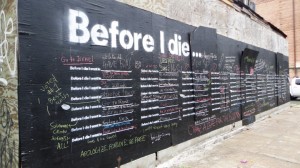 The desires written on this project reflect our altruism; one person writes “save a life” while another writes “make a difference.” Others affirm community, such as “see my daughter graduate” while another writes “understand.” Still others are about having fun and traveling, which affirm the goodness of the world around us. Our hopes, dreams, and aspirations are all gifts from God. We often want to deny them, out of fear of failure (or sometimes, if we really look deep, we find that we are actually afraid of success!).
The desires written on this project reflect our altruism; one person writes “save a life” while another writes “make a difference.” Others affirm community, such as “see my daughter graduate” while another writes “understand.” Still others are about having fun and traveling, which affirm the goodness of the world around us. Our hopes, dreams, and aspirations are all gifts from God. We often want to deny them, out of fear of failure (or sometimes, if we really look deep, we find that we are actually afraid of success!).
I strongly believe these desires come from God; I believe they are gifts that show us what our purpose is. They help us discern just who we have been created to be. The pitfall here is to get very specific with our desire. The reality of life is that sometimes our specific desires—to get married for example, or to enter a particular career—do not come to fruition. But this does not mean that God has turned away from us, that our desires are not important. What we need to do is look deeper. Was the desire for marriage the cover for the deeper desire for intimacy? For trusting relationships? For fidelity? How can these desires be manifest in other relationships besides marriage?
So, what would you write on this wall? What is the deep desire underneath that? And what does this tell you about your purpose?
The following is the full text of the March edition of my monthly column, Tea & Empathy, in the Redmond UMC Newsletter. Click here to go to the RUMC website to download the newsletter.
“What are you giving up for Lent?”
When I was in high school, this question was frequently heard among my friends during Lent and in the weeks leading up to it. It was usually answered with something like meat, chocolate, caffeine, TV, or video games. I seem to have noticed a shift in my community over the last 15 years since my high school days. Folks now talk about “taking something on” for Lent, or more readily admit to not making any changes during the Lenten season whatsoever. Fewer and fewer people are giving something up, or when they do, they link it to Lent only at the beginning—they intend it to be a permanent change after Lent is over.
I’ve been reflecting on what to make of this—is this good? Neutral? Problematic? I think we can gain some insight by looking at the history of Lent. It started way back in the days of the very early Christians, who would join baptismal candidates in fasting, praying, and confessing sins in the 40 hours prior to midnight on Easter. At midnight on Easter, all the baptismal candidates would be baptized. They would be given new white garments to wear and the whole church would join in a feast afterward, filled with the delicious foods and drinks they had been fasting from.
Eventually, this period of reflection, fasting, praying, and confessing of sins—leading up to the celebration of the resurrection and new life of Easter—lengthened to 40 days. During this 40 day period (which did not, and still does not, include Sundays) Christians would fast from particular foods, such as meats (except fish) and chocolate. Sundays were (and still technically are) “feast days” where the fast is not observed.
The real value in this period of fasting is not in the specific item we refrain from, but an intentional way of reflecting on our actions, drawing closer to God, and gaining insight about the ways the Holy Spirit is nudging us to make changes. This might include giving something we love—a food item, a television show, Facebook—for the period of lent and then feasting on it when Lent is over. It might include making a change we intend to be more permanent, such as routinely flossing once a day or beginning an intentional prayer practice.
The tremendous gift of the church calendar is that it allows for times of reflection like Lent. It is also important that we accept and cherish these gifts in ways that draw us into deeper connection with God, and are not just because we feel we “should.” I invite all of us to be in prayerful consideration of how we might use this Lenten season to draw closer to God and gain deeper insight into our lives.
Be… Perfect?
Preached at Redmond United Methodist Church on February 20th, 2011
Texts: Leviticus 19: 1-2, 9-18; Matthew 5:38-48
